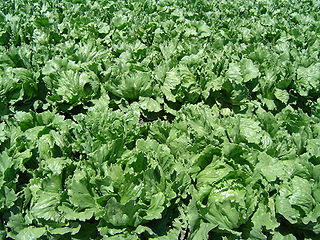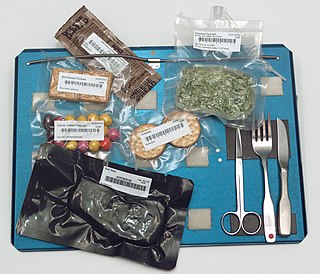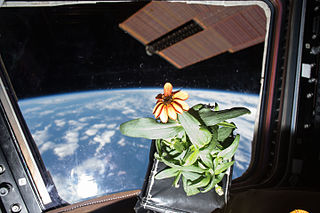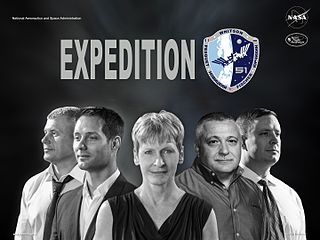
The International Space Station (ISS) is a large space station assembled and maintained in low Earth orbit by a collaboration of five space agencies and their contractors: NASA, Roscosmos (Russia), JAXA (Japan), ESA (Europe), and CSA (Canada). The ISS is the largest space station ever built. Its primary purpose is to perform microgravity and space environment experiments.

Lettuce is an annual plant of the family Asteraceae. It is most often grown as a leaf vegetable, but sometimes for its stem and seeds. Lettuce is most often used for salads, although it is also seen in other kinds of food, such as soups, sandwiches and wraps; it can also be grilled. One variety, celtuce, is grown for its stems, which are eaten either raw or cooked. In addition to its main use as a leafy green, it has also gathered religious and medicinal significance over centuries of human consumption. Europe and North America originally dominated the market for lettuce, but by the late 20th century the consumption of lettuce had spread throughout the world. As of 2021, world production of lettuce and chicory was 27 million tonnes, 53 percent of which came from China.

The Destiny module, also known as the U.S. Lab, is the primary operating facility for U.S. research payloads aboard the International Space Station (ISS). It was berthed to the Unity module and activated over a period of five days in February, 2001. Destiny is NASA's first permanent operating orbital research station since Skylab was vacated in February 1974.

Aeroponics is the process of cultivating plants in an air or mist environment, eliminating the need for soil or an aggregate medium. The term "aeroponic" originates from the ancient Greek: aer (air) and ponos. It falls under the category of hydroponics, as water is employed in aeroponics to deliver nutrients to the plants.

Mizuna, kyouna (京菜), Japanese mustard greens, or spider mustard, is a cultivar of Brassica rapa var. niposinica.

Space food is a type of food product created and processed for consumption by astronauts during missions to outer space. Such food has specific requirements to provide a balanced diet and adequate nutrition for individuals working in space while being easy and safe to store, prepare and consume in the machinery-filled weightless environments of crewed spacecraft. Space food is commonly freeze-dried to minimize weight and ensure long shelf life.

The Space Station Processing Facility (SSPF) is a three-story industrial building at Kennedy Space Center for the manufacture and processing of flight hardware, modules, structural components and solar arrays of the International Space Station, and future space stations and commercial spacecraft. It was built in 1992 at the space complex's industrial area, just east of the Operations and Checkout Building.

Astrobotany is an applied sub-discipline of botany that is the study of plants in space environments. It is a branch of astrobiology and botany.

Napa cabbage is a type of Chinese cabbage originating near the Beijing region of China that is widely used in East Asian cuisine. Since the 20th century, it has also become a widespread crop in Europe, the Americas and Australia. In much of the world, it is referred to as "Chinese cabbage". In Australia it is sometimes referred to as "wombok".

Nutrient film technique (NFT) is a hydroponic technique where in a very shallow stream of water containing all the dissolved nutrients required for plant growth is re-circulated past the bare roots of plants in a watertight gully, also known as channels.

TROPI, or "Analysis of a Novel Sensory Mechanism in Root Phototropism", is an experiment on the International Space Station (ISS) to investigate the growth and development of plant seedlings under various gravity and lighting combinations. It was launched on Space Shuttle Endeavour during the STS-130 mission and was performed on the ISS during Expedition 22. Frozen plant samples from the TROPI experiment were returned on the landing of the STS-131 mission on Space Shuttle Discovery.

The International Space Station is a platform for scientific research that requires one or more of the unusual conditions present in low Earth orbit. The primary fields of research include human research, space medicine, life sciences, physical sciences, astronomy and meteorology. The 2005 NASA Authorization Act designated the American segment of the International Space Station as a national laboratory with the goal of increasing the use of the ISS by other federal agencies and the private sector.

Expedition 39 was the 39th expedition to the International Space Station. It marked the first time the ISS had been under command of a Japanese astronaut, space veteran Koichi Wakata. After Expedition 21 in 2009 and Expedition 35 in 2013, it was only the third time an ISS crew was led by neither a NASA nor an RSA crew member.

SpaceX CRS-3, also known as SpX-3, was a Commercial Resupply Service mission to the International Space Station (ISS), contracted to NASA, which was launched on 18 April 2014. It was the fifth flight for SpaceX's uncrewed Dragon cargo spacecraft and the third SpaceX operational mission contracted to NASA under a Commercial Resupply Services (CRS-1) contract.

Space farming refers to the cultivation of crops for food and other materials in space or on off-Earth celestial objects – equivalent to agriculture on Moon.

The growth of plants in outer space has elicited much scientific interest. In the late 20th and early 21st century, plants were often taken into space in low Earth orbit to be grown in a weightless but pressurized controlled environment, sometimes called space gardens. In the context of human spaceflight, they can be consumed as food and provide a refreshing atmosphere. Plants can metabolize carbon dioxide in the air to produce valuable oxygen, and can help control cabin humidity. Growing plants in space may provide a psychological benefit to human spaceflight crews. Usually the plants were part of studies or technical development to further develop space gardens or conduct science experiments. To date plants taken into space have had mostly scientific interest, with only limited contributions to the functionality of the spacecraft, however the Apollo Moon tree project was more or less forestry inspired mission and the trees are part of a country's bicentennial celebration.

Foodscaping is a modern term for the practice of integrating edible plants into ornamental landscapes. It is also referred to as edible landscaping and has been described as a crossbreed between landscaping and farming. As an ideology, foodscaping aims to show that edible plants are not only consumable but can also be appreciated for their aesthetic qualities. Foodscaping spaces are seen as multi-functional landscapes which are visually attractive and also provide edible returns. Foodscaping is a great way to provide fresh food in an affordable way.

Expedition 51 was the 51st expedition to the International Space Station, which began upon the departure of Soyuz MS-02 on April 10, 2017, and concluded upon the departure of Soyuz MS-03 on June 2, 2017. Peggy Whitson, Oleg Novitskiy and Thomas Pesquet were transferred from Expedition 50, with Peggy Whitson taking the commander role. She is the first woman to command two expeditions to the ISS, having previously commanded Expedition 16.

A Beautiful Planet is an IMAX Entertainment documentary produced in collaboration with NASA and filmed aboard the International Space Station by astronaut crews. Narrated by Jennifer Lawrence, it was produced and directed by Toni Myers.

Expedition 53 was the 53rd expedition to the International Space Station, which began upon the departure of Soyuz MS-04 on September 2, 2017, and concluded upon the departure of Soyuz MS-05 on December 14, 2017. Randolph Bresnik, Paolo Nespoli and Sergey Ryazansky were transferred from Expedition 52, with Randolph Bresnik taking the commander role. Transfer of Command from Expedition 53 to Expedition 54 was done on December 13, 2017. Expedition 53 officially ended on December 14, 2017 5:14 UTC, with the undocking of Soyuz MS-05.























